Easy Baked Salmon is the kind of recipe that checks every box. It’s fast, it’s healthy, it’s flavorful, and it doesn’t demand any fancy cooking skills. Whether juggling a busy weeknight or hosting friends on short notice, this dish slides right into your dinner plans without the stress.
There’s something comforting about a meal you can trust to turn out right every time. Salmon brings that reliability with bonus points for nutrition and versatility. Add a few pantry staples, toss it in the oven, and have dinner in under half an hour. That’s the kind of magic we all need in our back pocket.
Plus, this isn’t just a one-flavor wonder. The beauty of baked salmon is how easily it picks up different flavors depending on what you’re craving. From zesty lemon and garlic to a sweet maple glaze or a spicy rub, you have endless ways to change it while keeping the process easy.
Whether you’re a beginner in the kitchen or just want something low-effort that still feels like an authentic meal, this Easy Baked Salmon recipe fits the bill.
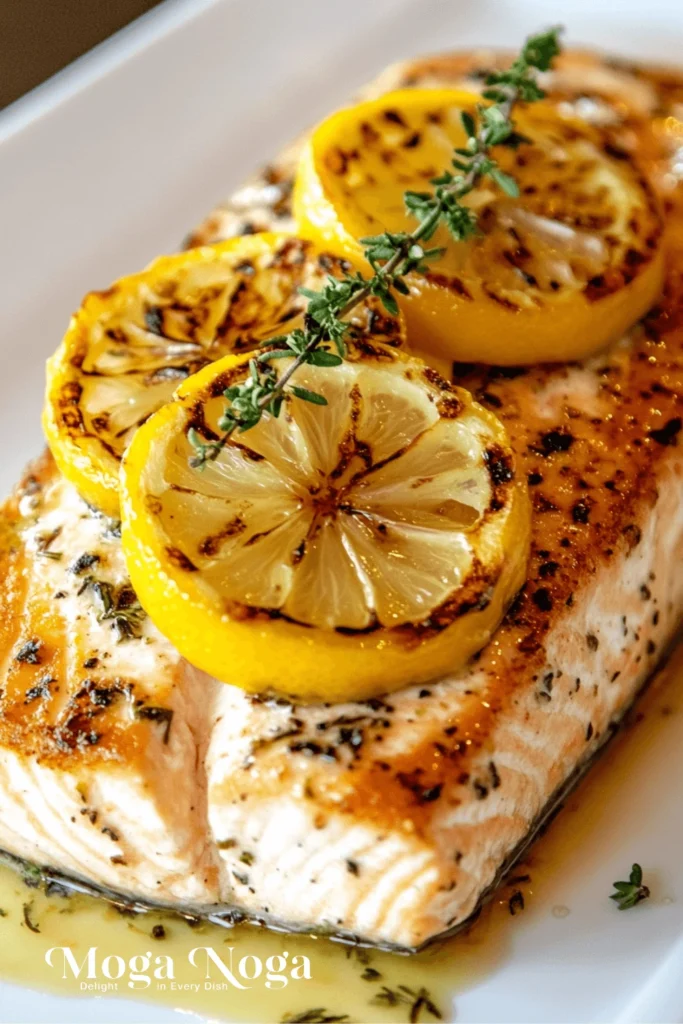
Table of Contents
Why You’ll Love This Recipe
Let’s be real—everyone wants more go-to recipes that don’t involve stress. Easy Baked Salmon makes that happen. It doesn’t need marinating, complex prep, or a long list of ingredients. The steps are so simple that even someone new to cooking can pull it off confidently.
It’s also perfect for eating clean without feeling like you’re giving anything up. The salmon is naturally rich in healthy fats and protein and low in carbs, which fits your dietary plan. Keto? Check. Mediterranean diet? Yup. Whole30 or gluten-free? Absolutely.
Another big reason people love it is that it scales like a dream. Whether cooking for one or feeding a family of five, multiply the fillets and line them up. There’s no need to alter the cooking time much unless the pieces are thicker or thinner than average.
If you like meals that feel fresh and bright, salmon delivers. With a few squeezes of lemon and fresh herbs, you have a plate that tastes light but satisfying. Want it a little richer? Try a drizzle of garlic butter or a swipe of aioli on the side. You’ve got options.
In short, it’s the kind of meal that works. And it keeps working, no matter how often it’s on the table.
Detailed Ingredients and Instructions
Let’s break this down even further so you know exactly what you’re working with. Starting with the salmon itself.
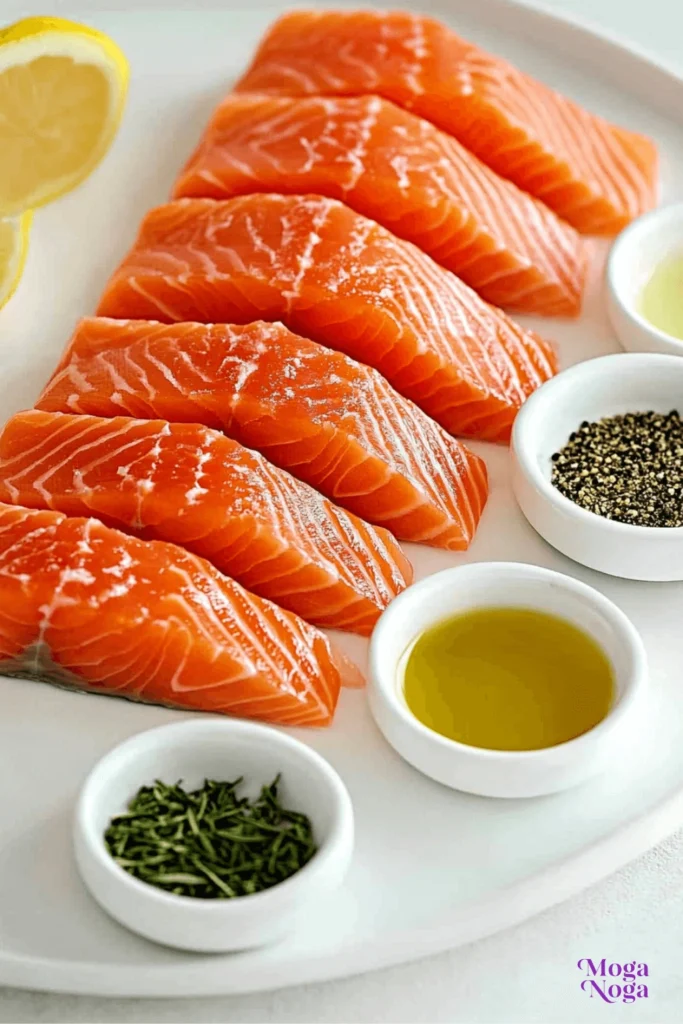
Choose the Right Salmon
You can use either fresh or frozen fillets. Ensure the frozen salmon is fully thawed and patted dry before baking. Skin-on fillets are ideal because they hold together better and have more flavor, but skinless works too.
Look for vibrant pink-orange flesh with a slightly firm texture. That’s how you know it’s fresh. Wild-caught is leaner and has a distinct flavor, while farm-raised tends to be milder and more buttery.
Olive Oil and Lemon Juice
This combo adds flavor and moisture. Brushing the top of the salmon with olive oil helps it stay tender and prevents the top from drying out. Lemon adds brightness and cuts through the richness, mainly when used fresh.
Garlic
Fresh minced garlic brings a big flavor. You don’t need a lot—just a clove or two, finely chopped or grated, goes a long way. Garlic powder works in a pinch, but fresh is better for texture and taste.
Salt and Pepper
These basics matter. Don’t skip or skimp. Sprinkle salt evenly and finish with freshly cracked pepper. It’s all about balance, which helps bring out the natural richness of the fish.
Optional Herbs
Dill is a classic with salmon, especially when paired with lemon. Parsley works if you want something milder. You can also try thyme, rosemary, or a pinch of tarragon if you feel fancy.
Baking
Oven at four hundred degrees. That’s the sweet spot for even cooking without drying out the fish. Depending on thickness, most fillets take twelve to fifteen minutes. The key is don’t overbake. The salmon should be cooked through—still moist, flaky, and tender.
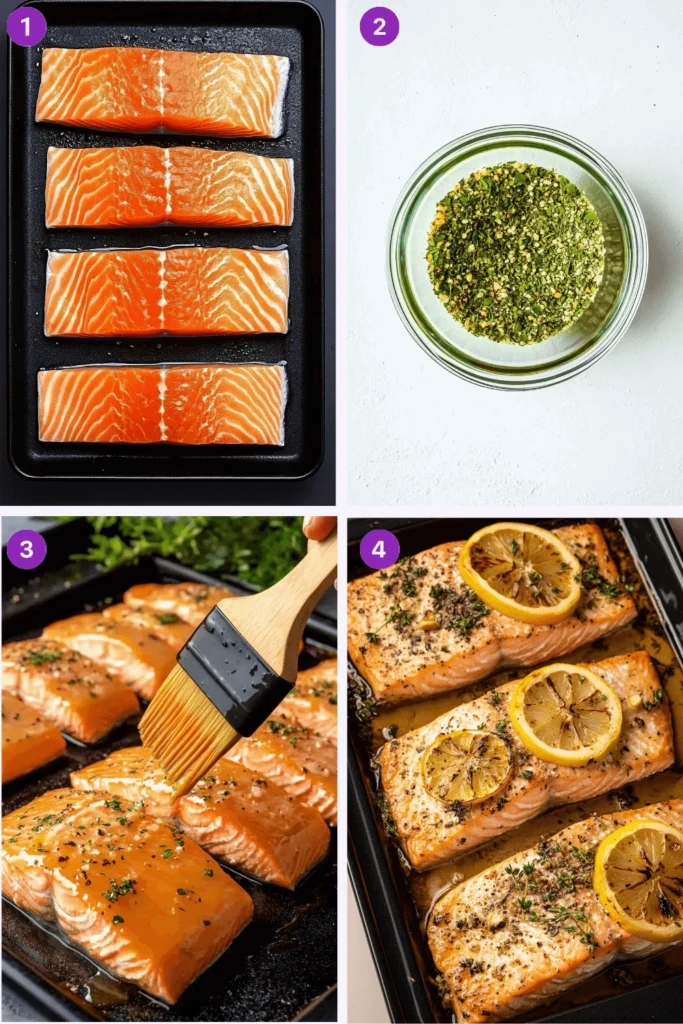
A good rule of thumb is four to six minutes of baking time per half-inch of thickness. If the fillet is thick in the middle, you might need a minute or two more. Don’t worry if the center is slightly darker—it will finish cooking with residual heat once out of the oven.
Tips, Variations, and Storage Options
One of the great things about Easy Baked Salmon is how flexible it is. You can keep it simple or switch it up depending on what you have in the fridge or what flavors you want. Here are some tips and ideas to ensure your salmon is always a hit.
Cooking Tips That Make a Difference
First up—don’t overcook it. That’s the number one mistake. Salmon can go from tender to dry fast, especially in a hot oven. Start checking around the twelve-minute mark. Press gently on the top with a fork; if it flakes easily, it’s done.
If you’re unsure, use a thermometer. The sweet spot is around one hundred and twenty-five degrees in the thickest part. That’s when the fish is safe but still juicy.
Always preheat your oven before the salmon goes in. You want an even cook, not sudden high heat that can dry out the edges before the middle’s ready.
And let it rest. Just a couple of minutes after baking helps everything settle and hold moisture.
Flavor Variations to Try
The base recipe is simple so you can play around with flavors often.
For a sweet twist, mix maple syrup or honey with a bit of mustard and brush it over the top before baking. Add a dash of paprika for some warmth.
If you’re craving bold flavors, try a Cajun-style rub. Mixing smoked paprika, garlic powder, onion powder, thyme, and cayenne works excellent.
For something more savory, soy sauce and sesame oil with a pinch of ginger create a nice umami profile. Finish with green onions and sesame seeds for a bit of crunch.
Want to go to the Mediterranean? After baking, use lemon, oregano, garlic, and a little crumbled feta. Add cherry tomatoes to roast alongside the salmon for extra flavor and color.
Storage and Leftovers
Got extras? Store leftover salmon in an airtight container in the fridge. It’ll stay suitable for up to three days.
Reheat gently in the microwave or oven—don’t overdo it. Leftover salmon is also fantastic cold. Flake it over salads, stir it into pasta, or mash it with some mayo and lemon juice for a quick sandwich filling.
You can freeze it, but the texture might be slightly different once thawed. It’s still great for mixing into cooked dishes, though.
Equipment Needed
You don’t need anything fancy to make Easy Baked Salmon, but having the right tools can make things smoother.
Sheet Pan or Baking Dish: This is where your salmon bakes. Line it with parchment paper or foil for easy cleanup. A baking dish works if you want to catch more juices for later spooning.
Sharp Knife: Suitable for trimming the salmon if needed and chopping garlic or herbs. A sharp blade helps keep the fillet neat.
Spatula: It helps transfer the salmon from the pan to your plate without falling apart. A fish spatula is ideal, but any thin, flat spatula will do the job.
Measuring Spoons: For consistent seasoning and mixing, glaze or marinades if you’re customizing the flavor.
Oven Thermometer (Optional): Nice to have if you’re unsure about your oven’s temperature. Salmon does best when the heat is just right.
That’s it. Simple tools, minimal cleanup, and dinner are served.
Related Recipes
If you love Easy Baked Salmon, here are a few more ideas to keep things interesting without complicating your routine.
Garlic Butter Shrimp: Quick and flavorful, just like salmon. This dish uses similar ingredients, so it’s an excellent backup for something different but familiar.
Sheet Pan Lemon Chicken: Also made in the oven with minimal cleanup. Toss some veggies on the pan and have a full meal without extra work.
Honey Soy Glazed Tofu: For a plant-based option that still feels hearty and satisfying. Great with rice or stir-fried veggies.
Baked Cod with Herbs: Another mild fish that works well with lemon and garlic. Perfect if you want something lighter than salmon but still tasty.
Roasted Veggie Quinoa Bowls: A solid side or main. Add flaked salmon to turn it into a protein-packed bowl ready for lunch or dinner.
These recipes share the same philosophy—easy, flavorful, and no stress.
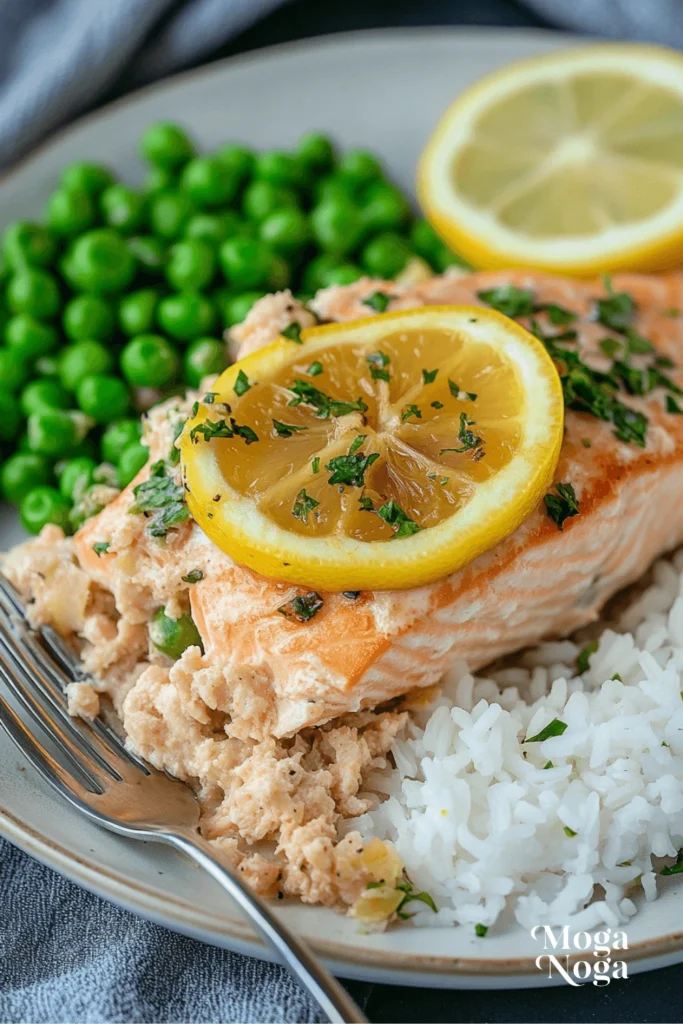
Pairing/Serving Suggestions
A great dish like Easy Baked Salmon deserves solid pairings. Here are a few sides and drinks that go perfectly without overshadowing the main event.
Sides That Work Every Time
Roasted vegetables are a classic. Try asparagus, broccoli, or Brussels sprouts tossed in olive oil and roasted until crispy.
A light salad is also a solid choice—something with greens, cucumber, and maybe a little vinaigrette. It keeps things fresh and balances the richness of the fish.
Go with rice, couscous, or mashed potatoes if you want something more filling. Lemon rice or herbed couscous brings in subtle flavor without much extra effort.
Pair it with roasted sweet potatoes or a warm grain bowl with farro or quinoa for a cozy twist.
Drink Pairings
White wine like Sauvignon Blanc or Chardonnay is a safe bet. If you prefer beer, a light lager or pale ale complements the flavors without overpowering.
Sparkling water with lemon or cucumber is a non-alcoholic option that adds a little flair to the meal without extra sugar.
Desserts to Finish It Off
Something light keeps the meal balanced. Think fruit salad, lemon sorbet, or yogurt with honey and berries. You don’t need much—just something sweet to end on a good note.
Frequently Asked Questions
Even a simple recipe like Easy Baked Salmon can raise a few questions, especially if you’re making it for the first time. The most common ones are answered clearly so you can confidently cook.
How do I know when the salmon is done?
The best way is to check if it flakes easily with a fork. Just press gently on the top with the flat edge of a fork. If it separates into tender layers and looks opaque, it’s ready. If you’re using a thermometer, the center should hit around one hundred and twenty-five degrees.
Do I have to remove the skin before baking?
Nope. Keeping the skin on during baking helps protect the fish from drying out. It also adds flavor. Once cooked, the skin will easily separate from the flesh if you prefer not to eat it.
Can I use frozen salmon?
Absolutely. Just make sure it’s fully thawed before baking. Pat it dry with paper towels to remove excess moisture, which helps it bake more evenly and get that nice, slightly crisp top.
What’s the difference between wild and farmed salmon?
Wild salmon is usually leaner and has a deeper, richer flavor. Farmed salmon tends to be milder and more buttery, with a slightly higher fat content. Both work for this recipe—it’s mostly a matter of personal taste and availability.
Is it safe to eat slightly pink salmon in the center?
Yes, as long as the internal temperature reaches the recommended level. Slightly pink doesn’t mean undercooked—it often indicates the fish is moist and properly cooked. Dry or chalky salmon usually means it’s been in the oven too long.
Can I bake salmon in foil?
Yes, it’s a great option if you want it extra moist. Just place the salmon on a piece of foil, season as usual, then wrap it loosely and seal the edges. Bake as normal. This creates a mini steam pocket that locks in flavor.
Can I use the same method for other types of fish?
You can. This recipe works well for flaky fish like trout, cod, halibut, or tilapia. Adjust the cooking time based on thickness, but the general process stays the same.
Nutrition Information
Easy Baked Salmon isn’t just tasty—it’s also a powerhouse of nutrition. Here’s what you’re generally getting per serving when using an average six-ounce fillet and a light olive oil-lemon-garlic seasoning:
- Calories; About two hundred and seventy to three hundred, depending on how much oil you use. If you add sauces or glazes, expect the number to increase slightly.
- Protein: Each serving packs around thirty-five grams of high-quality protein. That’s enough to keep you full and support muscle health, energy, and recovery.
- Fats: You’ll get about fifteen grams of fat, mainly from the healthy kind—omega-3 three fatty acids. These are great for heart health, brain function, and lowering inflammation.
- Carbohydrates: Virtually zero. This dish is naturally low-carb Unless you add sweet sauces or sides.
- Vitamins and Minerals: Salmon is rich in vitamin B, vitamin D, selenium, and potassium. These support your nervous system, bone health, immune function, and more.
- Sodium: This depends on how much salt you use if you’re watching your intake, season lightly or use alternatives like citrus and herbs to enhance flavor.
Overall, Easy Baked Salmon makes a strong case for being a weekly staple—not just for the flavor but for supporting a balanced, nutrient-rich diet.
Seasonal and Occasion Variations
One of the best things about this recipe is how easily you can adapt it to fit the season or a special occasion. Here’s how to give it a fresh twist all year long.
Spring Vibes
Pair the salmon with a pea, mint salad, asparagus, and lemon zest. Add fresh dill and a light yogurt sauce with cucumber for a bright finish.
Summer Refresh
Go tropical. Use a mango salsa on top of the baked salmon and serve it with coconut rice or grilled corn. Light, colorful, and perfect for warm evenings.
Fall Comfort
Try a maple and mustard glaze with roasted root vegetables on the side. The slight sweetness pairs well with fall produce like carrots, squash, or parsnips.
Winter Warmth
Go bold. Add a miso glaze or a soy-ginger combo, and pair it with sautéed greens or garlic mashed potatoes. It feels cozy but still clean.
Holidays and Entertaining
Want to impress without stress? Add a herbed breadcrumb topping and bake until golden. Serve with green beans and wild rice for a festive but easy dinner.
For a more elegant, shareable setup, you can also serve it sliced on a large platter with fresh herbs, lemon slices, and a dipping sauce.
Whatever the season or reason, you don’t have to reinvent the recipe—swap out sides or add a new topping to keep things interesting.
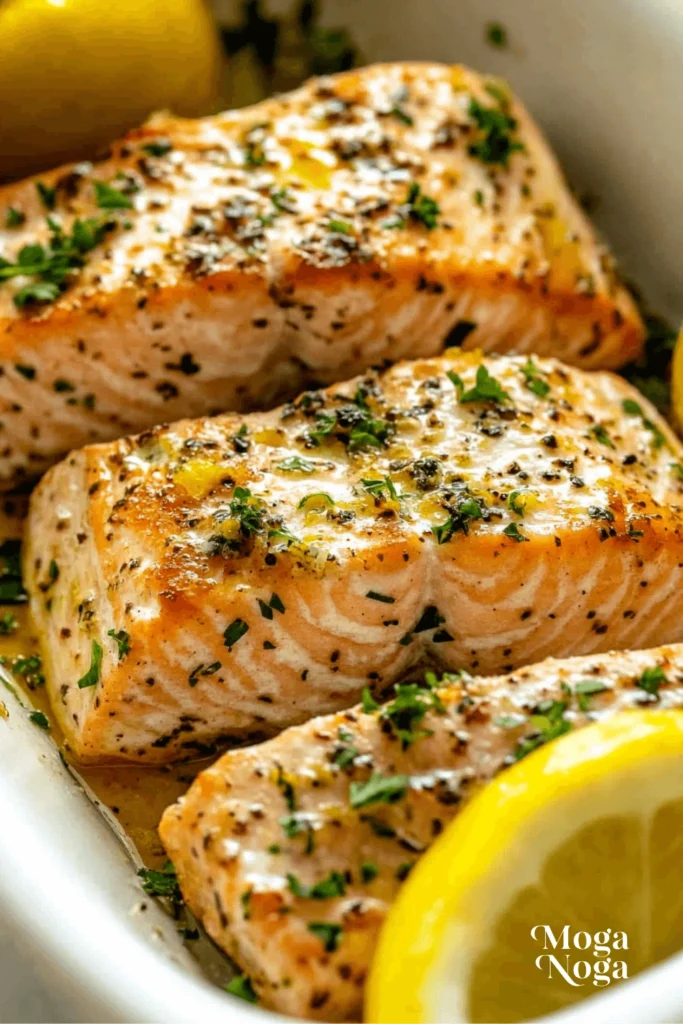
My Recipe Tips
Let’s be honest—simple recipes can still go sideways if you miss a minor detail. These tips help ensure your Easy Baked Salmon comes out right every time.
- Start with dry salmon.: Always pat the salmon dry with paper towels before seasoning it. Any excess moisture on the surface can create steam and stop the top from getting that nice, slightly crisp texture you want.
- Room temperature is best.: Let the salmon sit out for ten to fifteen minutes before baking. Starting with cold fish straight from the fridge can lead to uneven cooking, with the outside done before the inside.
- Go light on the seasoning at first.: Loading up on salt or garlic is tempting, but salmon doesn’t need much help. Start simple—then build flavor over time as you find your favorites. Remember, you can always add more after baking but can’t remove it.
- Know your oven: Every oven runs a little differently. If your salmon is dry, try turning the heat down a notch next time. If it’s underdone, you may need a couple more minutes. Make notes—it helps.
- Use parchment or foil wisely.: Lining your pan helps keep cleanup fast, but it also helps keep the fish from sticking. Parchment is excellent for crispy edges. Foil your friend if you add glaze or want softer, steamier results.
- Let it rest after baking.: This might seem minor, but it matters. Just two to three minutes of rest lets the juices settle so the salmon stays moist. Slice too soon, and you might lose that tender bite.
- Test different thicknesses: Not all salmon fillets are the same. Thinner pieces bake fast and can dry out quickly. Thicker ones need a bit more time but give you a juicier finish. Keep an eye on size and adjust your bake time accordingly.
Conclusion
Easy Baked Salmon is one of those rare meals that lives up to its name. It’s fast, flexible, and full of flavor. Whether you’re in a rush or don’t feel like fussing with dinner, it’s always a reliable choice. Plus, it fits into just about every eating style without extra planning.
You don’t need fancy ingredients or special skills. Just a few basics, a hot oven, and a good piece of salmon. And once you’ve made it a couple of times, you’ll probably find yourself coming back to it week after week. It’s just that kind of recipe.
So the next time you’re wondering what’s for dinner, skip the stress and go with something easy, tasty, and good for you. Easy Baked Salmon has your back—no guesswork, no cleanup drama, just solid food that feels a little special even on an average night.
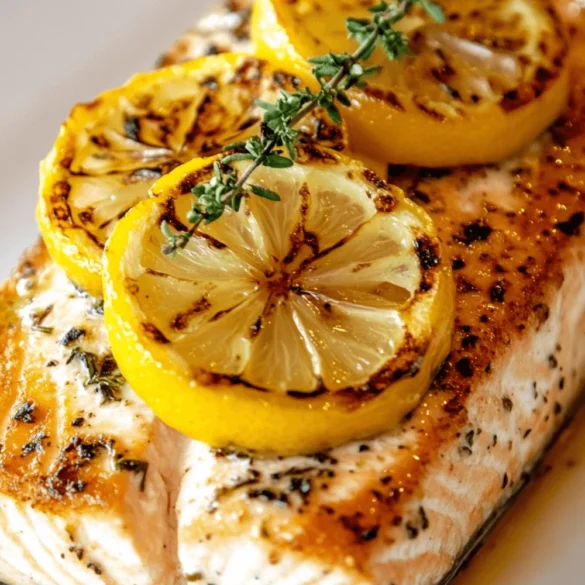
🐟 Easy Baked Salmon 🍋🍽️
Ingredients
4 salmon fillets (6 oz each)
2 tablespoons olive oil
1 tablespoon lemon juice
1 teaspoon garlic powder
1 teaspoon dried dill
Salt and pepper, to taste
1 lemon, sliced (for garnish)
Fresh parsley, chopped (optional, for garnish)
Instructions
Preheat the oven: Preheat your oven to 400°F (200°C). Line a baking sheet with parchment paper or lightly grease it.
Prepare the salmon: Place the salmon fillets on the prepared baking sheet. Drizzle olive oil and lemon juice over each fillet. Sprinkle with garlic powder, dried dill, salt, and pepper.
Bake the salmon: Bake the salmon in the preheated oven for 12-15 minutes, or until the salmon flakes easily with a fork and reaches an internal temperature of 145°F (63°C). The baking time will depend on the thickness of the fillets.
Serve: Remove the salmon from the oven. Garnish with lemon slices and fresh parsley if desired. Serve immediately with your favorite sides.

